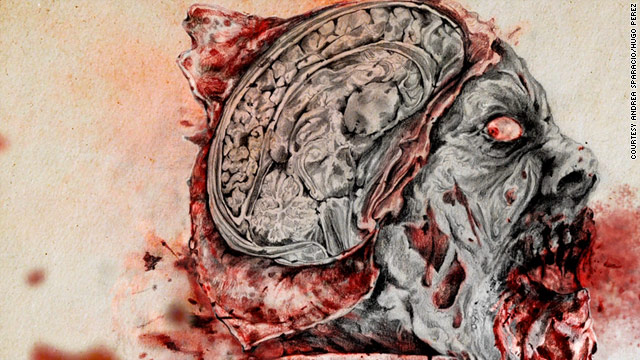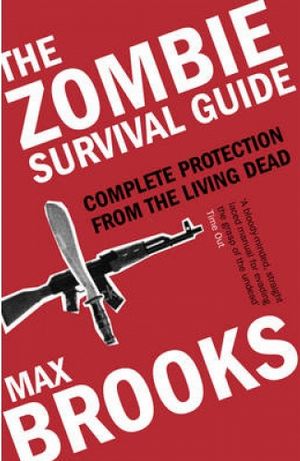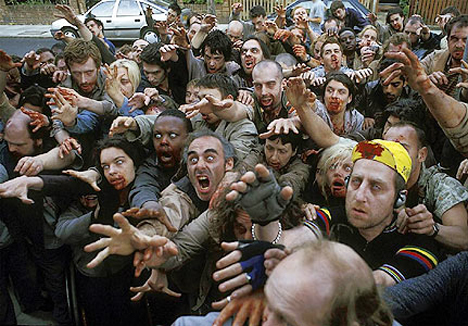Tag Archives: outbreak
Zombie apocalypse outbreak spreading?
A second grisly zombie-like incident, this time in New Jersey. A 43-year-old man named Wayne Carter stabbed himself 50 times. Then when a SWAT team arrived Carter began throwing his intestines at them. He is now in a hospital. Combined with the recent Miami face-eater, Patrick Jones wonders if bath salts and insanity is the kick off of the zombie apocalypse. Watch the video report at the bottom of this column.
Inside zombie brains: Sci-fi teaches science

- A new novel “The Zombie Autopsies” is about, well, zombies
- The zombie virus basically eats the brain down to the amygdala
- When it’s humans vs. zombies, the best solution is a strategic attack, mathematician says
Zombie author and expert Dr. Steven Schlozman will join us for a Twitter chat at 12:00 p.m. ET on Tuesday, April 26. Tweet your questions to @cnnhealth and follow along at #cnnzombies.
(CNN) — An airborne virus is rapidly turning people into zombies. Two-thirds of humanity has been wiped out. Scientists desperately look for a cure, even as their own brains deteriorate and the disease robs them of what we consider life.
Relax, it’s only fiction — at least, for now. This apocalyptic scenario frames the new novel “The Zombie Autopsies” by Dr. Steven Schlozman, a child psychiatrist who holds positions at Harvard Medical School and the Massachusetts General Hospital/McLean Program in Child Psychiatry.
You might not expect someone with those credentials to take zombies seriously, but it turns out the undead are a great way to explore real-world health issues: why certain nasty diseases can destroy the brain, how global pandemics create chaos and fear, and what should be done about people infected with a highly contagious and incurable lethal illness.
“One of the things zombie novels do is they bring up all these existential concerns that happen in medicine all the time: How do you define what’s alive?” says Schlozman, who has been known to bounce between zombie fan conventions and academic meetings.
“When is it appropriate to say someone’s ‘as-good-as-dead,’ which is an awful, difficult decision?”
What a zombie virus would do to the brain
So maybe you’ve seen “Night of the Living Dead,” read “World War Z,” or can’t wait for the return of the AMC show “The Walking Dead,” but you probably don’t know what differentiates the brains of humans and zombies.
First things first: How does the zombie disease infect its victims? Many stories in the genre talk about biting, but Schlozman’s novel imagines a deliberately engineered virus whose particles can travel in the air and remain potent enough to jump from one person to another in a single sneeze.
Now, then, to the brain-eating. The zombie virus as Schlozman describes it basically gnaws the brain down to the amygdala, an almond-shaped structure responsible for the “fight or flight” response. The zombies always respond by fighting because another critical part of the brain, the ventromedial hypothalamus, which tells you when you’ve eaten enough, is broken.
The brain’s frontal lobes, responsible for problem-solving, are devoured by the virus, so zombies can’t make complex decisions. Impairment in the cerebellum means they can’t walk well, either. Also, these humanoids have an unexplained predilection for eating human flesh.
“The zombies in this book are stumbling, shambling, hungry as hell,” Schlozman said. “Basically they’re like drunk crocodiles; they’re not smart, they don’t know who you are or what you are.”
Why we love those rotting, hungry, putrid zombies
How a zombie virus would be made
So the bloodthirsty undead wander (or crawl) around spreading a lethal illness ominously called ataxic neurodegenerative satiety deficiency syndrome, or ANSD, for short.
“When something really terrifying comes along, especially in medicine or that has a medical feel to it, we always give it initials. That’s the way we distance ourselves from it,” Schlozman said.
The virus has several brain-destroying components, one of which is a “prion,” meaning a protein like the one that causes mad cow disease. In real life, prions twist when they are in an acidic environment and become dangerous, Schlozman said. How our own environment has changed to make prions infectious — getting from the soil to the cows in mad cow disease, for instance — is still a mystery.
Now here’s something to send chills up your spine: In Schlozman’s world, airborne prions can be infectious, meaning mad cow disease and similar nervous-system destroyers could theoretically spread just like the flu. Swiss and German researchers recently found that mice that had only one minute of exposure to aerosols containing prions died of mad cow disease, as reported in the journal PLoS Pathogens. A follow-up described in Journal of the American Medical Association showed the same for a related disease that’s only found in animals called scrapie. Of course, these are mice in artificially controlled conditions in a laboratory, and humans do not exhale prions, but it could have implications for safety practices nonetheless.
Like mad cow disease, the zombie disease Schlozman describes also progresses in acidic environments. In the book, a major corporation doles out implantable meters that infuse the body with chemicals to artificially lower acidity when it gets too high. But, sadly, when acidity is too low, that also induces symptoms that mimic the zombie virus, so it’s not a longterm solution. Everyone who gets exposed eventually succumbs, Schlozman said.
As for the unknown component of the zombie disease that would help slowly zombifying researchers in their quest for a cure, that’s up for the reader to figure out — and the clues are all in the book, Schlozman said.
How we’d fight back
You can’t ethically round up fellow survivors to kick some zombie butt unless the undead have technically died. And in Schlozman’s book, a group of religious leaders get together and decide that when people reach stage four of the disease, they are basically dead. That, of course, permits zombie “deanimation,” or killing.
The ‘zombie theology’ behind the walking dead
And how do you kill a zombie? Much of zombie fiction knocks out zombies through shots to the head. That, Schlozman said, is because the brain stem governs the most basic functioning: breathing and heartbeat.
A zombie-apocalypse disease like the one he describes probably wouldn’t evolve on its own in the real world, he said.
But, as we’ve seen, individual symptoms of zombies do correspond to real ailments. And if they all came together, the disease would be creepily efficient at claiming bodies, Schlozman said.
Bad news, folks: Even if people contracted a zombie virus through bites, the odds of our survival aren’t great.
A mathematician at the University of Ottawa named Robert Smith? (who uses the question mark to distinguish himself from other Robert Smiths, of course), has calculated that if one zombie were introduced to a city of 500,000 people, after about seven days, every human would either be dead or a zombie.
“We’re in big, big trouble if this ever happens,” Smith? said. “We can kill the zombies a bit, but we’re not very good at killing zombies fundamentally. What tends to happen is: The zombies just win, and the more they win, the more they keep winning” because the disease spreads so rapidly.
The best solution is a strategic attack, rather than an “every man for himself” defense scenario, he said. It would take knowledge and intelligence, neither of which zombies have, to prevail.
Why study zombies?
In his day job, Smith? models how real infectious diseases spread. But he’s already reaped benefits from his work on zombies. For instance, while many mathematical models only deal with one complicated aspect of a situation at a time, he tackled two — zombie infection and zombie-killing — when it came to speculating about outbreaks.
When it came time for modeling of real-world human papillomavirus (HPV), then, Smith? felt equipped to handle many facets of it at the same time, such as heterosexual and homosexual transmission of HPV.
“Knowing what we knew from zombies allowed us to actually take on these more complicated models without fear,” he said.
Studying zombies is also a great way to get young people excited about science. Smith?, who was on a zombie-science panel with Schlozman through the National Academy of Sciences’ Science and Entertainment Exchange in 2009, has also seen math-phobic people get interested in mathematics by reading about his work with zombies.
“There are insights that we gain from the movies, and from fiction, from fun popular culture stuff, that actually can really help us think about the way that science works, and also the way science is communicated,” he said.
And as to why people like reading about zombies and watching zombies so much, Schlozman points to the impersonal nature of things in our society, from waiting in line in the DMV to being placed on hold on a call with a health insurance company.
Think about all the situations in daily life where you sense a general lack of respect for humanity, and zombies make a little more sense.
“The zombies themselves represent a kind of commentary on modernity,” Schlozman says. “We’re increasingly disconnected. That might be the current appeal.”
Zombie Outbreak – Miami ‘zombie’ attacker may have been using ‘bath salts’
A naked man who chewed off the face of another man in what is being called a zombie-like attack may have been under the influence of “bath salts,” a drug referred to as the new LSD, according to reports from CNN affiliates in Miami.
The horrific attack occurred Saturday and was only stopped after a police officer shot the attacker several times, killing him.
Larry Vega witnessed the attack on Miami’s MacArthur Causeway. He told CNN affiliate WSVN he saw one naked man chewing off the face of another naked man.
 Rudy Eugene
Rudy Eugene
“The guy was like tearing him to pieces with his mouth, so I told him, ‘Get off!'” Vega told WSVN. “You know it’s like the guy just kept eating the other guy away, like ripping his skin.”
“It was just a blob of blood,” WSVN quoted Vega as saying. “You couldn’t really see, it was just blood all over the place.”
Vega said he flagged down a passing police officer.
“When the officer approached him, told him to stop, pointed a gun at him, he turned around and growled like a wild animal and kept eating at the man’s face,” Fraternal Order of Police President Armando Aguilar told CNN affiliate WPLG.
Augilar said he suspects the attacker, identified as 31-year-old Rudy Eugene, was under the influence of “bath salts.” Four other drug use instances in Miami-Dade bear resemblances to Saturday’s attack, he told WPLG.
“It causes them to go completely insane and become very violent” and take off their clothes, Augilar told WPLG.
Dr. Paul Adams, an emergency room physician at Jackson Memorial Hospital in Miami, told CNN affiliate WBFS that the drug makes users delirious. They exhibit elevated temperatures and extreme physical strength, Adams said.
“I took care of a 150 pound individual who you would have thought he was 250 pounds,” WBFS quoted Adams as saying. “It took six security officers to restrain the individual.”
Adams said users have been known to use their jaws as weapons, according to WBFS.
According to a 2011 report from the National Institute of Drug Abuse, bath salts contain amphetamine-like chemicals.
“Doctors and clinicians at U.S. poison centers have indicated that ingesting or snorting ‘bath salts’ containing synthetic stimulants can cause chest pains, increased blood pressure, increased heart rate, agitation, hallucinations, extreme paranoia, and delusions,” according to the NIDA report.
In October, the Drug Enforcement Administration made possession of the stimulants in bath salts, Mephedrone, 3,4 methylenedioxypyrovalerone (MDPV) and Methylone, illegal under an emergency order. The order lasts for a year with a possible six-month extension.
The stimulants have been placed under restrictions or banned in 37 states, according to a DEA press release.
The victim of Saturday’s attack, whom police have not identified, was in critical condition at Jackson Memorial on Monday, according to the WPLG report. Augilar told WPLG that 75% to 80% of his face was missing.
Eugene had an arrest record, mostly misdemeanors, including a battery charge from when he was 16 that was later dropped, according to the Miami Herald.
He had been married but divorced in 2007, WPLG reported. His former wife told the station that Eugene had been violent toward her.
Homeless people near where the attack took place said Eugene was often seen around the area looking confused, according to WPLG.
Zombie Survival Guide Review
The Zombie Survival Guide: Complete Protection from the Living Dead
Let’s face it: at one time or another we’ve all faced a zombie scare we aren’t prepared for. And yes, the local constabulary usually cleans things up with a minimum of fuss, but what happens when things go wrong and the cavalry doesn’t arrive? That, my friends, is the day that Max Brooks’ “The Zombie Survival Guide” saves your life. With several millennia worth of field experience distilled into a manageable 254 pages, everything you need to know to survive the coming war with the undead can be found in these pages. Your life and the lives of those you love are at stake, act now and be prepared!
for. And yes, the local constabulary usually cleans things up with a minimum of fuss, but what happens when things go wrong and the cavalry doesn’t arrive? That, my friends, is the day that Max Brooks’ “The Zombie Survival Guide” saves your life. With several millennia worth of field experience distilled into a manageable 254 pages, everything you need to know to survive the coming war with the undead can be found in these pages. Your life and the lives of those you love are at stake, act now and be prepared!
OK, so that paragraph was obviously tongue in cheek, but hopefully in conveys some sense of what Brooks’ remarkable “The Zombie Survival Guide” is like. While obviously a parody of both the horror genre and civil defense/survivalist manuals, it maintains an “all-business” demeanor, never once cracking the façade to reveal the underlying humoristic intent. The result is a book that is, when taken as a whole, a funny, incredibly thorough work of satire. However, at the same time, page-by-page, it is a rather accomplished addition to zombie horror.
Starting with zombie physiology and then moving on to weapons, tactics, long-term strategy and history Brooks has produced a manual which has a thoroughness that belies the absurdity of its subject. Point by point he discusses the pros and cons of rifles, machetes and flamethrowers, then considers the optimal defensive positions for various types of outbreaks. After an extensive discussion of survival in a zombie doomsday scenario, he lays out zombie outbreaks through history, and what their implications are. Throughout, entries are extensively cross-referenced and alternative courses of action are always weighed for potential risks and benefits.
The remarkable thing about all this is that Brooks has managed to infuse a tension, and urgency into his manual that makes for great reading. Part post-apocalyptic fiction, part “Night of the Living Dead” and part “Saturday Night Live” sketch, this is a book that should hold appeal across a broad range of genres. Thorough without being dry, creepy without being clichéd, and funny without relying on cheap laughs, “The Zombie Survival Guide” is undoubtedly one of the most original books I have ever read, and one that I enjoyed reading immensely. If you appreciate any or all of these genres, or if you just enjoy a well executed, original idea, this is definitely a book you’ll want to check out.
And remember…Tomorrow may be too late, read this book today!
